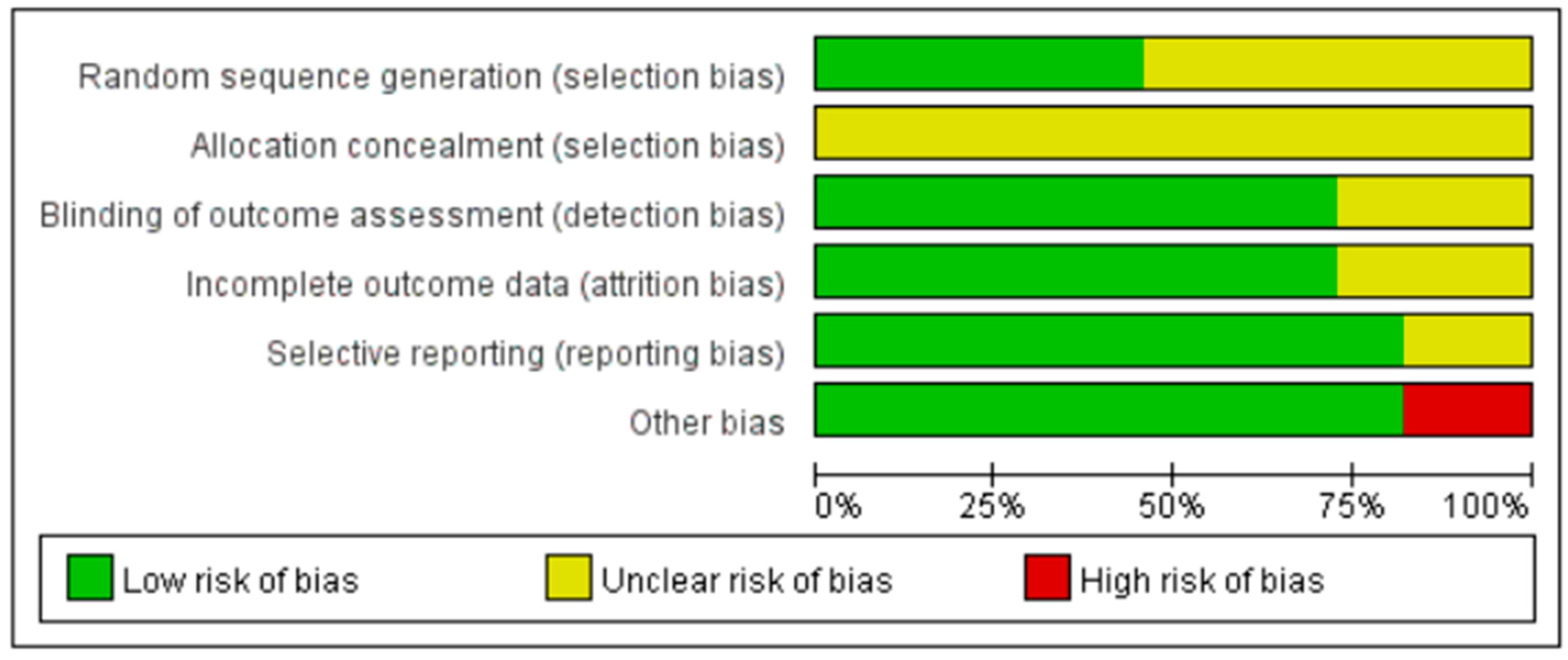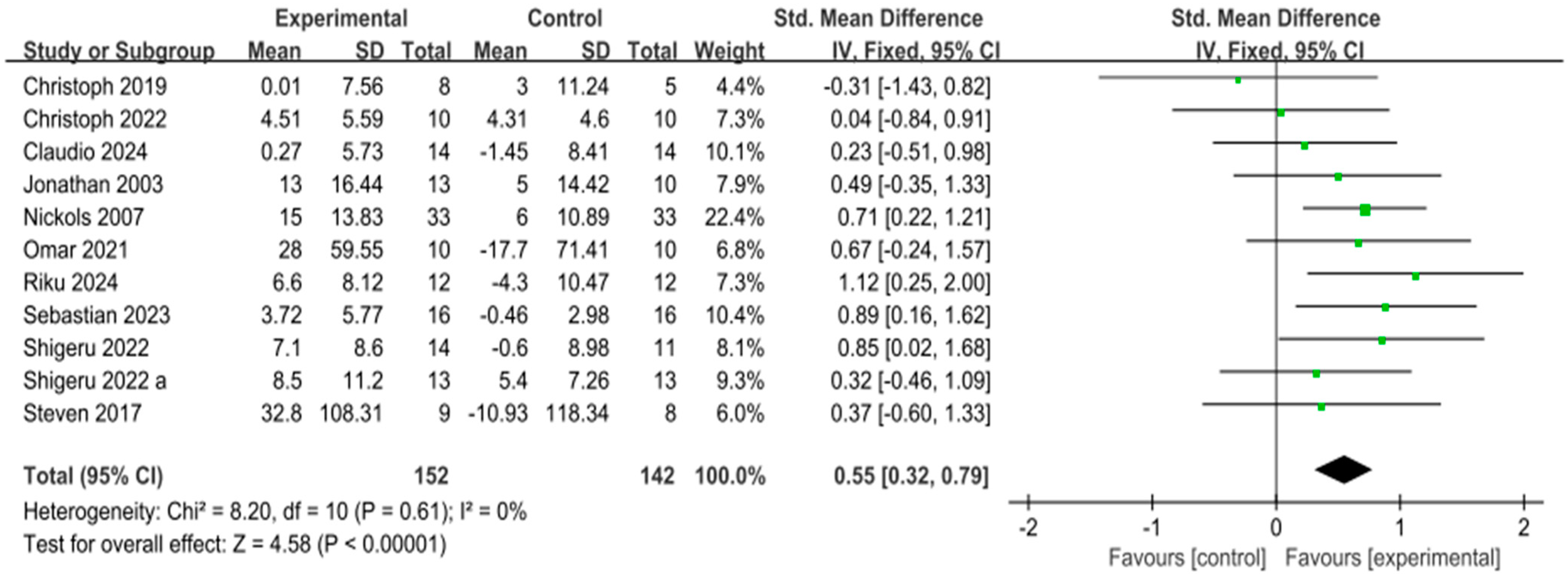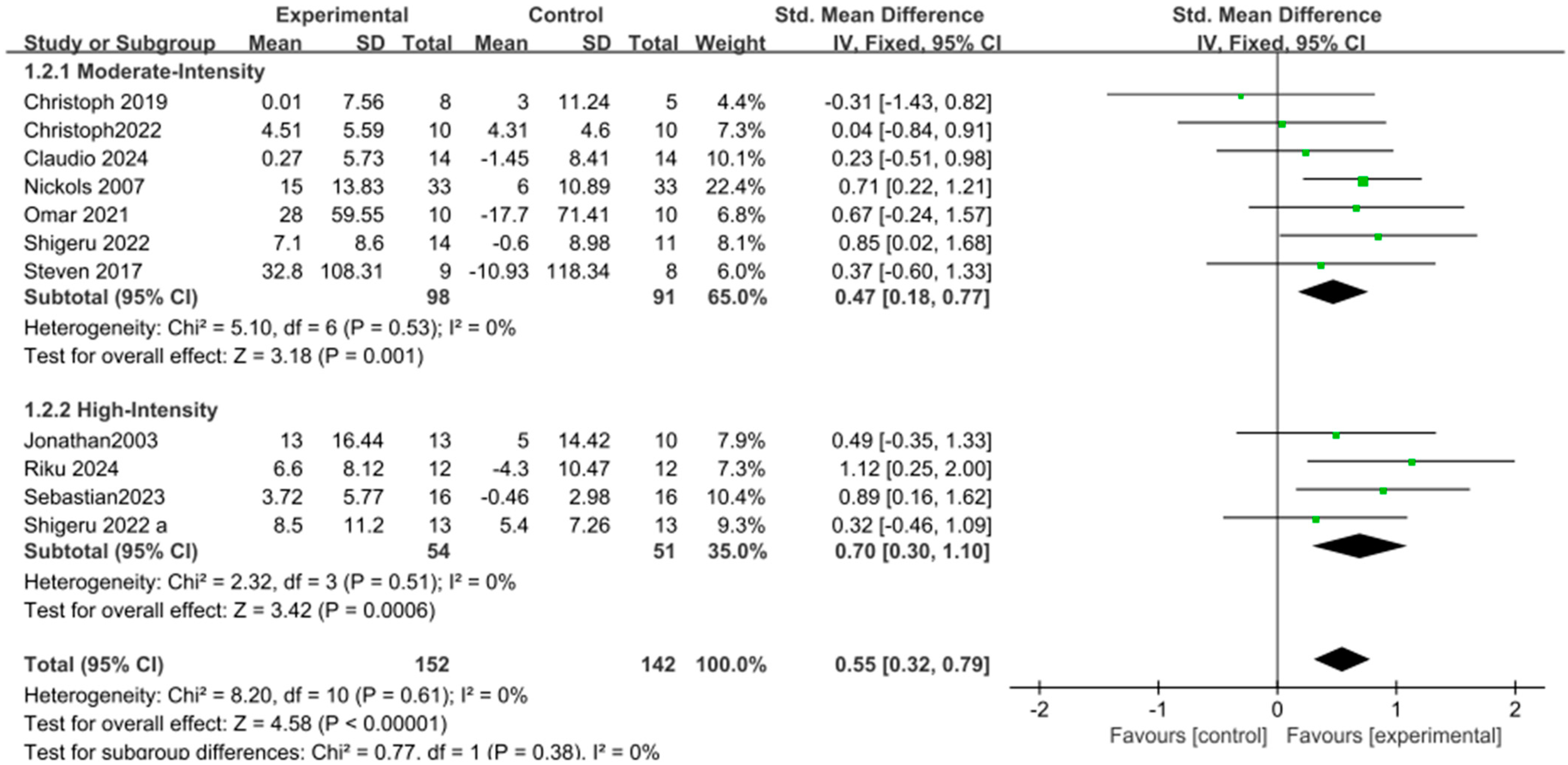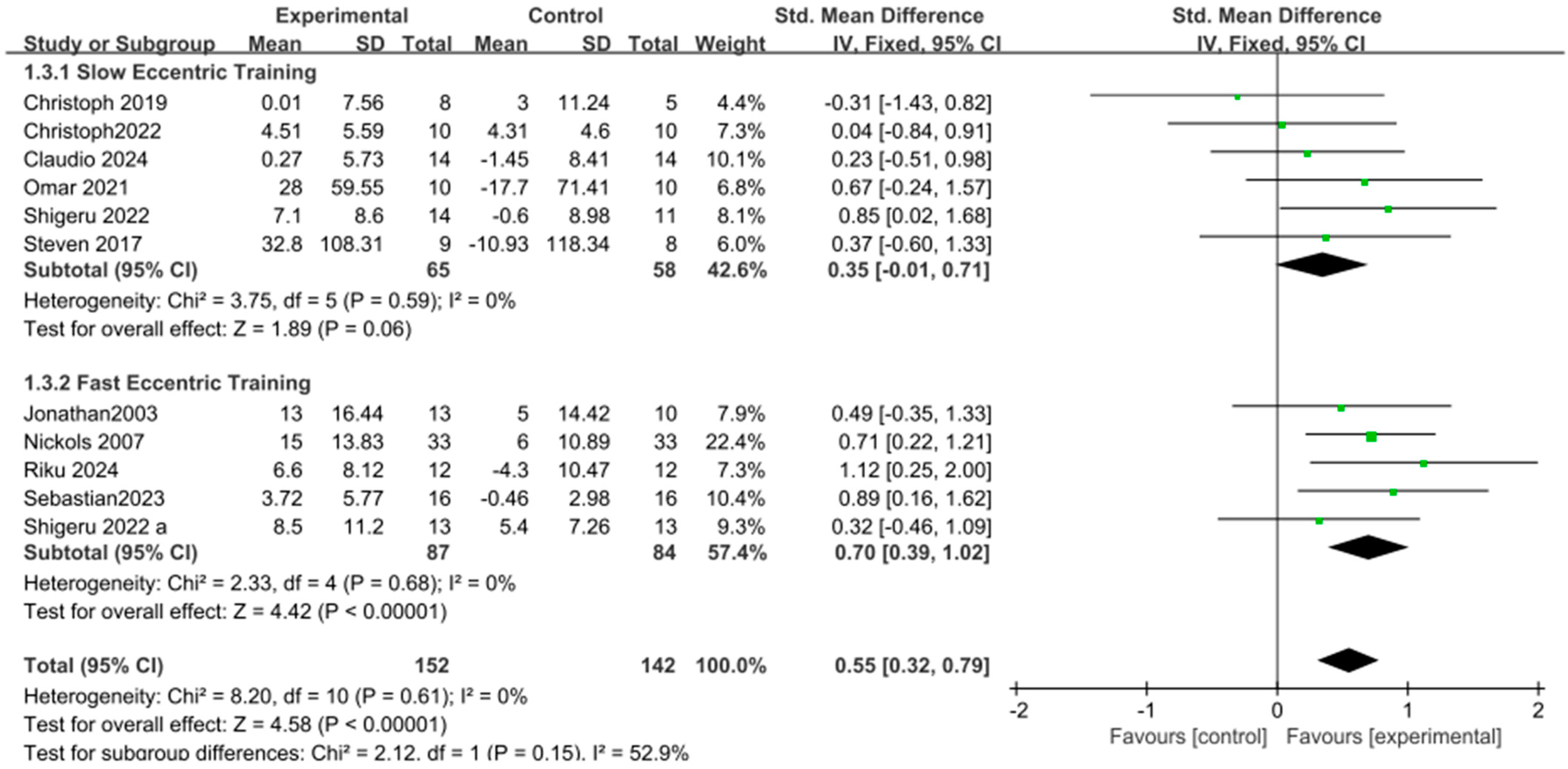Effect of Eccentric Training with Different Durations, Intensities, and Contraction Velocities on Upper Limb Muscle Strength: A Meta-Analysis
Abstract
1. Introduction
2. Materials and Methods
2.1. Search Strategy
2.2. Study Selection
2.3. Data Extraction
2.4. Quality Assessment
2.5. Sensitivity Analysis
2.6. Statistical Analysis
3. Results
3.1. Included Studies
3.2. Description of the Included Trials
3.3. Quality Assessment
3.4. Synthesis of the Results
4. Discussion
4.1. Main Findings
4.2. Training Implications
5. Conclusions
Author Contributions
Funding
Institutional Review Board Statement
Informed Consent Statement
Data Availability Statement
Conflicts of Interest
References
- Di Domenico, D.; Forsiuk, I.; Müller-Cleve, S.; Tanzarella, S.; Garro, F.; Marinelli, A.; Canepa, M.; Laffranchi, M.; Chiappalone, M.; Bartolozzi, C.; et al. Reach&Grasp: A multimodal dataset of the whole upper-limb during simple and complex movements. Sci. Data 2025, 12, 233. [Google Scholar] [CrossRef] [PubMed]
- Brambilla, C.; Russo, M.; d’Avella, A.; Scano, A. Phasic and tonic muscle synergies are different in number, structure and sparseness. Hum. Mov. Sci. 2023, 92, 103148. [Google Scholar] [CrossRef] [PubMed]
- Curovic, I.; Grecic, D.; Rhodes, D.; Alexander, J.; Harper, D.J. Potential Importance of Maximal Upper Body Strength-Generating Qualities and Upper Body Strength Training for Performance of High-Intensity Running and Jumping Actions: A Scoping Review. Sports 2024, 12, 357. [Google Scholar] [CrossRef] [PubMed]
- Vigouroux, L.; Devise, M. Pull-Up Performance Is Affected Differently by the Muscle Contraction Regimens Practiced during Training among Climbers. Bioengineering 2024, 11, 85. [Google Scholar] [CrossRef]
- Pontzer, H.; Holloway, J.H., 4th; Raichlen, D.A.; Lieberman, D.E. Control and function of arm swing in human walking and running. J. Exp. Biol. 2009, 212 Pt 4, 523–534. [Google Scholar] [CrossRef]
- Lees, A.; Vanrenterghem, J.; De Clercq, D. Understanding how an arm swing enhances performance in the vertical jump. J. Biomech. 2004, 37, 1929–1940. [Google Scholar] [CrossRef]
- Job, T.D.W.; Cross, M.R., 3rd; Cronin, J.B. Relationship of shoulder internal and external rotation peak force and rate of force development to throwing velocity in high school and collegiate pitchers. J. Biomech. 2024, 176, 112339. [Google Scholar] [CrossRef]
- Barbosa, T.M.; Bragada, J.A.; Reis, V.M.; Marinho, D.A.; Carvalho, C.; Silva, A.J. Energetics and biomechanics as determining factors of swimming performance: Updating the state of the art. J. Sci. Med. Sport 2010, 13, 262–269. [Google Scholar] [CrossRef]
- Schärer, C.; Bucher, P.; Lüthy, F.; Hübner, K. Combined Eccentric-Isokinetic and Isoinertial Training Leads to Large Ring-Specific Strength Gains in Elite Gymnasts. Sports 2022, 10, 49. [Google Scholar] [CrossRef]
- Valdes, O.; Ramirez, C.; Perez, F.; Garcia-Vicencio, S.; Nosaka, K.; Penailillo, L. Contralateral effects of eccentric resistance training on immobilized arm. Scand. J. Med. Sci. Sports 2021, 31, 76–90. [Google Scholar] [CrossRef]
- Sato, S.; Yoshida, R.; Murakoshi, F.; Sasaki, Y.; Yahata, K.; Kasahara, K.; Nunes, J.P.; Nosaka, K.; Nakamura, M. Comparison between concentric-only, eccentric-only, and concentric-eccentric resistance training of the elbow flexors for their effects on muscle strength and hypertrophy. Eur. J. Appl. Physiol. 2022, 122, 2607–2614. [Google Scholar] [CrossRef]
- Komi, P.V. Stretch-shortening cycle: A powerful model to study normal and fatigued muscle. J. Biomech. 2000, 33, 1197–1206. [Google Scholar] [CrossRef] [PubMed]
- Franchi, M.V.; Reeves, N.D.; Narici, M.V. Skeletal Muscle Remodeling in Response to Eccentric vs. Concentric Loading: Morphological, Molecular, and Metabolic Adaptations. Front. Physiol. 2017, 8, 447. [Google Scholar] [CrossRef]
- Roig, M.; O’brien, K.; Kirk, G.; Murray, R.; McKinnon, P.; Shadgan, B.; Reid, W.D. The effects of eccentric versus concentric resistance training on muscle strength and mass in healthy adults: A systematic review with meta-analysis. Br. J. Sports Med. 2008, 43, 556–568. [Google Scholar] [CrossRef]
- Hortobagyi, T.; Hill, J.P.; Houmard, J.A.; Fraser, D.D.; Lambert, N.J.; Israel, R.G. Adaptive responses to muscle lengthening and shortening in humans. J. Appl. Physiol. 1996, 80, 765–772. [Google Scholar] [CrossRef] [PubMed]
- Ben Moussa, A.Z.; Zouita, S.; Ben Salah, F.; Behm, D.; Chaouachi, A. Isokinetic trunk strength, validity, reliability, normative data and relation to physical performance and low back pain: A review of the literature. Int. J. Sports Phys. Ther. 2020, 15, 160–174. [Google Scholar] [CrossRef]
- Markovic, G.; Mikulic, P. Neuro-musculoskeletal and performance adaptations to lower-extremity plyometric training. Sports Med. 2010, 40, 859–895. [Google Scholar] [CrossRef]
- Aagaard, P.; Simonsen, E.B.; Andersen, J.L.; Magnusson, P.; Dyhre-Poulsen, P. Increased rate of force development and neural drive of human skeletal muscle following resistance training. J. Appl. Physiol. 2002, 93, 1318–1326. [Google Scholar] [CrossRef]
- Hessel, A.L.; Lindstedt, S.L.; Nishikawa, K.C. Physiological Mechanisms of Eccentric Contraction and Its Applications: A Role for the Giant Titin Protein. Front. Physiol. 2017, 9, 70. [Google Scholar] [CrossRef]
- Baxter, B.A.; Baross, A.W.; Ryan, D.J.; Tkadlec, S.; Kay, A.D. Effects of once- versus twice-weekly eccentric resistance training on muscular function and structure in older adults: A randomised controlled trial. Sci. Rep. 2024, 14, 1–14. [Google Scholar] [CrossRef]
- Xu, J.; Thompson, B.J.; Spencer, S.B.; Studenka, B.E.; Bressel, E. Effects of Flywheel Resistance Training on Muscle Function and Sport-Specific Performance in Collegiate Club Water Polo Players. Res. Q. Exerc. Sport 2022, 94, 98–109. [Google Scholar] [CrossRef] [PubMed]
- Schärer, C.; Tacchelli, L.; Göpfert, B.; Gross, M.; Lüthy, F.; Taube, W.; Hübner, K. Specific Eccentric-Isokinetic Cluster Training Improves Static Strength Elements on Rings for Elite Gymnasts. Int. J. Environ. Res. Public. Health 2019, 16, 4571. [Google Scholar] [CrossRef]
- Petré, H.; Wernstål, F.; Mattsson, C.M. Effects of Flywheel Training on Strength-Related Variables: A Meta-analysis. Sports Med.—Open 2018, 4, 1–15. [Google Scholar] [CrossRef]
- Higgins, J.P.T.; Thompson, S.G.; Deeks, J.J.; Altman, D.G. Measuring inconsistency in meta-analyses. BMJ 2003, 327, 557–560. [Google Scholar] [CrossRef]
- Murayama, M.; Inami, T.; Shima, N.; Yoneda, T.; Nosaka, K. Changes in biceps brachii muscle hardness assessed by a push-in meter and strain elastography after eccentric versus concentric contractions. Sci. Rep. 2022, 12, 9214. [Google Scholar] [CrossRef] [PubMed]
- Newton, M.J.; Sacco, P.; Chapman, D.; Nosaka, K. Do dominant and non-dominant arms respond similarly to maximal ec-centric exercise of the elbow flexors? J. Sci. Med. Sport 2013, 16, 166–171. [Google Scholar] [CrossRef]
- Nickols-Richardson, S.M.; Miller, L.E.; Wootten, D.F.; Ramp, W.K.; Herbert, W.G. Concentric and eccentric isokinetic resistance training similarly increases muscular strength, fat-free soft tissue mass, and specific bone mineral measurements in young women. Osteoporos Int. 2007, 18, 789–796. [Google Scholar] [CrossRef] [PubMed]
- Farthing, J.P.; Chilibeck, P.D. The effect of eccentric training at different velocities on cross-education. Eur. J. Appl. Physiol. 2003, 89, 570–577. [Google Scholar] [CrossRef]
- Elmer, S.J.; Anderson, D.J.; Wakeham, T.R.; Kilgas, M.A.; Durocher, J.J.; Lindstedt, S.L.; LaStayo, P.C. Chronic eccentric arm cycling improves maximum upper-body strength and power. Eur. J. Appl. Physiol. 2017, 117, 1473–1483. [Google Scholar] [CrossRef]
- Sato, S.; Yoshida, R.; Murakoshi, F.; Sasaki, Y.; Yahata, K.; Nosaka, K.; Nakamura, M. Effect of daily 3-s maximum voluntary isometric, concentric, or eccentric contraction on elbow flexor strength. Scand. J. Med. Sci. Sports 2022, 32, 833–843. [Google Scholar] [CrossRef]
- Vetter, S.; Hepp, P.; Schleichardt, A.; Schleifenbaum, S.; Witt, M.; Roth, C.; Köhler, H.-P. Effect of isokinetic eccentric training on the human shoulder strength, flexibility, and muscle architecture in physically active men: A preliminary study. PLoS ONE 2023, 18, e0293439. [Google Scholar] [CrossRef] [PubMed]
- Yoshida, R.; Murakami, Y.; Kasahara, K.; Sato, S.; Nosaka, K.; Nakamura, M. Minimum Intenasity of Daily Six Eccentric Contractions to Increase Muscle Strength and Size. Scand. J. Med. Sci. Sports 2024, 34, e14683. [Google Scholar] [CrossRef] [PubMed]
- Perret, C.; Käch, M.; Hertig-Godeschalk, A.; Ammann, F. Strength and power adaptations of the upper body following 20 training sessions on an eccentric arm-crank ergometer. Eur. J. Appl. Physiol. 2024, 124, 2777–2785. [Google Scholar] [CrossRef]
- Behm, D.G.; Alizadeh, S.; Daneshjoo, A.; Konrad, A. Potential Effects of Dynamic Stretching on Injury Incidence of Athletes: A Narrative Review of Risk Factors. Sports Med. 2023, 53, 1359–1373. [Google Scholar] [CrossRef]
- Suchomel, T.J.; Nimphius, S.; Bellon, C.R.; Stone, M.H. The Importance of Muscular Strength: Training Considerations. Sports Med. 2018, 48, 765–785. [Google Scholar] [CrossRef] [PubMed]
- Khalafi, M.; Malandish, A.; Rosenkranz, S.K.; Ravasi, A.A. Effect of resistance training with and without caloric restriction on visceral fat: A systemic review and meta-analysis. Obes. Rev. 2021, 22, e13275. [Google Scholar] [CrossRef]
- Seger, J.Y.; Arvidsson, B.; Thorstensson, A. Specific effects of eccentric and concentric training on muscle strength and morphology in humans. Eur. J. Appl. Physiol. 1998, 79, 49–57. [Google Scholar] [CrossRef]
- Clark, N.C.; Pethick, J.; Falla, D. Measuring complexity of muscle force control: Theoretical principles and clinical relevance in musculoskeletal research and practice. Musculoskelet. Sci. Pr. 2023, 64, 102725. [Google Scholar] [CrossRef]
- Freeman, B.W.; Young, W.B.; Talpey, S.W.; Smyth, A.M.; Pane, C.L.; Carlon, T.A. The effects of sprint training and the Nordic hamstring exercise on eccentric hamstring strength and sprint performance in adolescent athletes. J. Sports Med. Phys. Fit. 2019, 59, 1119–1125. [Google Scholar] [CrossRef]
- Fyfe, I.; Stanish, W.D. The use of eccentric training and stretching in the treatment and prevention of tendon injuries. Clin. Sports Med. 1992, 11, 601–624. [Google Scholar] [CrossRef]
- Mike, J.N.; Cole, N.; Herrera, C.; VanDusseldorp, T.; Kravitz, L.; Kerksick, C.M. The Effects of Eccentric Contraction Duration on Muscle Strength, Power Production, Vertical Jump, and Soreness. J. Strength Cond. Res. 2017, 31, 773–786. [Google Scholar] [CrossRef] [PubMed]
- Chen, J.; Wu, T.; Guo, Y. Nordic hamstring exercises in functional knee rehabilitation after anterior cruciate ligament reconstruction: A prospective, randomised, controlled study. Sci. Rep. 2023, 13, 1–8. [Google Scholar] [CrossRef]
- Pamart, N.; Drigny, J.; Azambourg, H.; Remilly, M.; Macquart, M.; Lefèvre, A.; Lahjaily, K.; Parienti, J.J.; Rocamora, A.; Guermont, H.; et al. Effects of a 20-Week High-Intensity Strength Training Program on Muscle Strength Gain and Cardiac Adaptation in Untrained Men: Preliminary Results of a Prospective Longitudinal Study. JMIR Form. Res. 2023, 7, e47876. [Google Scholar] [CrossRef] [PubMed]
- Liu, Y.; Zhang, J.; Hu, Z.; Zhong, Z.; Yuan, X. Acute effects of eccentric overload training with different loading doses in male sprinters. Heliyon 2024, 10, e32369. [Google Scholar] [CrossRef]
- Dolezal, S.M.; Llewellyn, T.L.; Frese, D.L. The Effects of Eccentric, Velocity-Based Training on Strength and Power in Collegiate Athletes. Int. J. Exerc. Sci. 2016, 9, 657–666. [Google Scholar] [CrossRef] [PubMed]
- Kongsgaard, M.; Kovanen, V.; Aagaard, P.; Doessing, S.; Hansen, P.; Laursen, A.H.; Kaldau, N.C.; Kjaer, M.; Magnusson, S.P. Corticosteroid injections, eccentric decline squat training and heavy slow resistance training in patellar tendinopathy. Scand. J. Med. Sci. Sports 2009, 19, 790–802. [Google Scholar] [CrossRef]
- Schoenfeld, B.J.; Wilson, J.M.; Lowery, R.P.; Krieger, J.W. Muscular adaptations in low- versus high-load resistance training: A meta-analysis. Eur. J. Sport Sci. 2014, 16, 1–10. [Google Scholar] [CrossRef]






| Study | Characteristics of Subject | Intervention Information | Outcomes | ||||||
|---|---|---|---|---|---|---|---|---|---|
| Number (Male/Female) | Age (Mean ± SD) | Type of Exercise | Intensity | Duration of Intervention and Loads | Period and Frequency (Week × Sessions per Week) | Supervised or Nonsupervised | Outcomes | Unit | |
| Jonathan (2003) [28] | 4 M 9 F | 21.9 ± 1.5 | RC | high | 2–6 sets of 8 reps at 75–90% 1RM 180°/s ECC and CON | 8 × 3 | supervised | muscle strength | NM |
| 7 M 6 F | 19.4 ± 0.6 | SC | high | 2–6 sets of 8 reps at 75–90% 1RM 30°/s ECC and CON | |||||
| 2 M 8 F | 22.7 ± 0.9 | No exercise | |||||||
| Nickols (2007) [27] | 33 F | 20.1 ± 1.4 | ECC | moderate | 5 sets of 6 reps at 60°/s ECC, 60–75% 1RM | 20 weeks | supervised | muscle strength | NM |
| 37 F | 20.2 ± 1.9 | CON | moderate | 5 sets of 6 reps at 60°/s CON, 60–75% 1RM | |||||
| Michael (2013) [26] | 18 M | 30.8 ± 1.2 | ECC | 10 sets of 6 reps at 1RM ECC | 2 weeks | supervised | muscle strength, muscle hypertrophy | KG | |
| Steven (2017) [29] | 9 | 23 ± 3 | ECC | moderate | 1 set of 10 reps at 1RM 75% ECC | 7 × 3 | supervised | muscle srength | KG |
| 8 | 24 ± 4 | CON | moderate | 1 set of 10 reps at 1RM 75% CON | |||||
| Christoph (2019) [22] | 9 | 21.4 ± 1.9 | ECC | moderate | 3–4 sets of 4 reps at 60–75% 1RM ECC | 4 × 2 | supervised | muscle strength | KG |
| Omar (2021) [10] | 6 M 4 F | 24.3 ± 3.5 | ECC | moderate | 3–6 sets of 10 reps at 60–75% 1RM ECC and CON | 4 × 3 | supervised | muscle strength | KG |
| 6 M 4 F | CON-ECC | moderate | 3–6 sets of 10 reps at 60–75% 1RM ECC and CON | ||||||
| 6 M 4 F | No exercise | ||||||||
| Shigeru (2022) [11] | 7 M 7 F | 21.1 ± 1.5 | CON-ECC | moderate | 3 sets of 10 reps at 60–75% 1RM 30°/s CON and 30°/s ECC | 5 × 2 | supervised | muscle strength, muscle hypertrophy | NM |
| 6 M 8 F | 20.6 ± 1.0 | CON | moderate | 3 sets of 10 reps at 60–75% 1RM 30°/s CON | |||||
| 7 M 7 F | 20.8 ± 1.0 | ECC | moderate | 3 sets of 10 reps at 60–75% 1RM 30°/s ECC | |||||
| 5 M 6 F | 21.2 ± 0.6 | No exercise | |||||||
| Shigeru (2022) [30] | 9 M 4 F | 21.0 ± 0.9 | MVC-ISO | high | 1 set of 1 rep at 75–90% 1RM MVC-ISO | 4 × 5 | supervised | muscle strength | NM |
| 9 M 4 F | 21.2 ± 0.7 | MVC-ECC | high | 1 set of 1 rep at 75–90% 1RM 30°/s ECC | |||||
| 10 M 3 F | 21.4 ± 0.7 | MVC-CON | high | 1 set of 1 rep at 75–90% 1RM 30°/s CON | |||||
| 7 M 3 F | 22.2 ± 0.7 | No exercise | |||||||
| Christoph (2022) [9] | 10 M | 22.1 ± 2.9 | IC | moderate | 2–3 sets of 4 reps at 60–75% 1RM ECC | 6 × 2 | supervised | muscle strength, strength endurance | KG |
| Mitsuyoshi (2022) [25] | 10 M | 25.8 ± 3.9 | ECC, CON | 5 sets of 10 reps at 1RM 50% ECC and CON | 1 × 4 | supervised | muscle hardness | KG | |
| Sebastian (2023) [31] | 16 M | 23.3 ± 3.9 | IC | high | 5 sets of 10 reps at 75–90% 1RM 30, 60, and 180°/s ECC | 6 × 2 | supervised | muscular structure | NM |
| Riku (2024) [32] | 8 M 4 F | 21.4 ± 1.2 | MVC-ECC | high | 1 set of 6 reps at 75–90% 1RM MVC-ECC | 4 weeks | supervised | muscle strength | NM |
| Claudio (2024) [33] | 5 M 9 F | 29.5 ± 2.5 | ECC | moderate | 20 reps at 60–75% 1RM ECC | 1 × 3 | supervised | muscle strength | KG |
Disclaimer/Publisher’s Note: The statements, opinions and data contained in all publications are solely those of the individual author(s) and contributor(s) and not of MDPI and/or the editor(s). MDPI and/or the editor(s) disclaim responsibility for any injury to people or property resulting from any ideas, methods, instructions or products referred to in the content. |
© 2025 by the authors. Licensee MDPI, Basel, Switzerland. This article is an open access article distributed under the terms and conditions of the Creative Commons Attribution (CC BY) license (https://creativecommons.org/licenses/by/4.0/).
Share and Cite
Bai, Z.; Zhang, D.; Liang, D.; Chen, X.; Shi, X.; Chen, S. Effect of Eccentric Training with Different Durations, Intensities, and Contraction Velocities on Upper Limb Muscle Strength: A Meta-Analysis. Life 2025, 15, 456. https://doi.org/10.3390/life15030456
Bai Z, Zhang D, Liang D, Chen X, Shi X, Chen S. Effect of Eccentric Training with Different Durations, Intensities, and Contraction Velocities on Upper Limb Muscle Strength: A Meta-Analysis. Life. 2025; 15(3):456. https://doi.org/10.3390/life15030456
Chicago/Turabian StyleBai, Zhe, Dong Zhang, Dongxue Liang, Xiaoke Chen, Xinyu Shi, and Shu Chen. 2025. "Effect of Eccentric Training with Different Durations, Intensities, and Contraction Velocities on Upper Limb Muscle Strength: A Meta-Analysis" Life 15, no. 3: 456. https://doi.org/10.3390/life15030456
APA StyleBai, Z., Zhang, D., Liang, D., Chen, X., Shi, X., & Chen, S. (2025). Effect of Eccentric Training with Different Durations, Intensities, and Contraction Velocities on Upper Limb Muscle Strength: A Meta-Analysis. Life, 15(3), 456. https://doi.org/10.3390/life15030456






